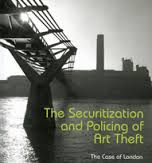Author: John Kerr
ISBN No: 978-1-4724-4451-6
Review date: 26/04/2024
No of pages: 204
Publisher: Ashgate
Publisher URL:
http://www.ashgate.com/default.aspx?page=637&title_id=20722&edition_id=1209352157&calcTitle=1
Year of publication: 16/07/2015
Brief:
Securitization and Policing of Art Theft: Case of London, by John Kerr
At the heart of London academic John Kerr’s book about the security and policing of the London art world, is an important piece of work, and a fascinating read, and UK private security could do with a dozen more such books written about other small worlds, writes Mark Rowe.
As an academic criminologist, at the University of Roehampton, Kerr evidently feels he has to follow academic convention and set out his credentials in an opening background chapter on theory. Skip this and dive straight into the meat of the book. Kerr has interviewed heads of security at museums and galleries, art theft detectives, loss adjusters and others with an interest in protection of works of art. He does what he says he’s done, ‘shed light on the under-researched configuration of the securitization and policing of art theft in London’. He goes over the ‘terrain’, which is partly public, partly private, police. Significantly, he writes in terms of risk: the London art market is risky; prices go up and down; the artists want the public or more to the point potential buyers to get close to their work and (having paid) get their eyes or even hands on it. Artworks may be on show in hotels, and universities, besides the obvious places, often packed with tourists most of the year (such as the Tate Modern, on the cover, looking from the Millennium Bridge). Being in public means having to embrace risk, such as malicious damage; indeed, in the modern art market, having your work damaged may bring good publicity – in the sense that any publicity is good – as it implies that someone cares about the artwork enough to attack it; it could be the making of a artist’s reputation, just as a cynical pop star promoter might secretly welcome a crush of fans, as it shows the pop star is liked.
Kerr does not go off on such tangents, but rather details the small world he has chosen to study. He takes in insurance as an ingredient of risk, but rightly also stresses the ‘market’ side of this small and vibrant world; with licit and illicit sides, and a grey area in between. Risks are not only theft (whether for a global market of buyers, or metal theft ignoring the value of the artwork) but flood and fire and the like. For all the academic hand-wringing about the relative rise of private policing or the relative decline of state policing, Kerr shows art security in London as working pretty well. London is part of an art world that swaps works for exhibition with Los Angeles or St Petersburg, or Rome. A thriving art market where buyers and sellers feel comfortable to do business in safety is good for the country. As Kerr identified, the prospect is of public budget cuts and the private sector doing more to secure art, which includes alarms and CCTV. Kerr points to related areas, ‘bubbles’ such as jewellery. He also notes the scope for other studies of security settings, such as pubs and clubs. Where Kerr has gone, hopefully others will follow.










